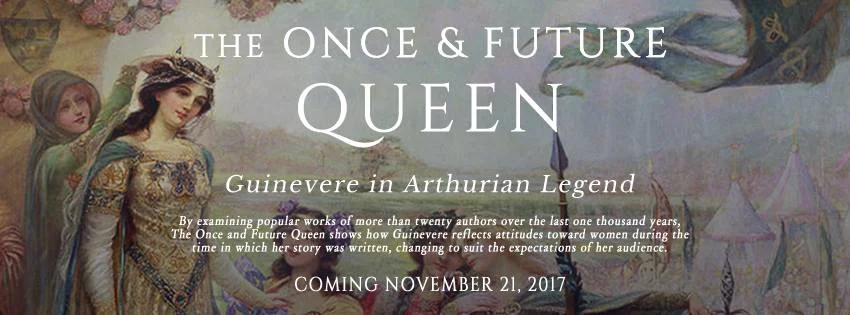Spotlight: The Once and Future Queen by Nicole Evelina
/Guinevere’s journey from literary sinner to feminist icon took over one thousand years…and it’s not over yet.
Literature tells us painfully little about Guinevere, mostly focusing on her sin and betrayal of Arthur and Camelot. As a result, she is often seen as a one-dimensional character. But there is more to her story. By examining popular works of more than 20 authors over the last one thousand years, The Once and Future Queen shows how Guinevere reflects attitudes toward women during the time in which her story was written, changing to suit the expectations of her audience. Beginning in Celtic times and continuing through the present day, this book synthesizes academic criticism and popular opinion into a highly readable, approachable work that fills a gap in Arthurian material available to the general public.
Nicole Evelina has spent more than 15 years studying Arthurian legend. She is also a feminist known for her fictional portrayals of strong historical and legendary women, including Guinevere. Now, she combines these two passions to examine the effect of changing times and attitudes on the character of Guinevere in a must-read book for Arthurian enthusiasts of every knowledge level.
Excerpt
INTRODUCTION
The name “Guinevere” conjures up evocative images from the pages of literature and the celluloid frames of film. From the long-haired queen weeping in contrition at Arthur’s feet while a heartbroken Lancelot looks on, to the ermine-clad Vanessa Redgrave singing a prayer to St. Genevieve while opining the simple joys of maidenhood, she does nothing by halves. Whether a reader first encounters her in the works of Thomas Malory or in a modern movie or TV adaptation, one thing is clear: Queen Guinevere is a woman to be reckoned with. She will not easily be lost within the pages of history, even if her better-known husband threatens to eclipse her and her reputation is lost in favor of tawdry remembrances of her sin.
History has proven Guinevere will not go down without a fight. Over the last thousand years, she has become a symbol of each society for which she is written, taking on its mores,
personifying its deepest fears, and providing a warning: take heed lest you too become a victim of sin. In more recent years, as women have come to demand an equal place in society, she has
become a symbol of feminism, the queen who owns her sexuality and isn’t willing to apologize for taking what she wants from life. To some, she is still a man-eater (as T. H. White famously dubbed her), but to others, she is the model of liberated womanhood they so desperately seek.
While the main subject of this book is the evolution of the character of Guinevere, it will also, by necessity, touch upon the roles of women, feminism, and the subject of religion; each is tightly interwoven with how Guinevere is portrayed by her authors. Religion, up until the last century or so, was a vital part of society and the everyday life of most people in Europe and the Americas. As such, it unconsciously affected the way they read Guinevere’s actions and the consequences she deserved. So when the Catholic Church became involved in crafting the Arthurian legend in the twelfth century, Guinevere took on the role of scapegoat for Arthur’s downfall, becoming both a victim of her own lust and the willing perpetrator of evil—the Eve for the world of Camelot. It is only when religion becomes less important to an increasingly secular society that Guinevere begins to be redeemed.
Likewise, the role of women in society was a given until women started to enter the workplace during World War I and later, in the 1970s, began to demand equal treatment outside the home. So it is not surprising that Guinevere started out as a peripheral character who was there to do her husband’s bidding and, at best, entertain his knights. Throughout the Middle Ages and even into the beginning of the twentieth century, women were treated as second class citizens whose role was to serve their husbands and bear children. While Guinevere excelled at the former, being barren, she failed to fulfill one of the key duties assigned to her as a woman and a queen: to bear a child. As such, she is fundamentally tainted, virtually predisposed to evil and weakness, as though she bore an extra original sin that doomed her to an unsavory fate.
As women began to fight for their rights in the 1970s and 1980s, Guinevere slowly emerged from the shadows, becoming a woman with a full backstory, a childhood, opinions and agendas
of her own, and a life after King Arthur’s death. With this success as a backdrop, authors of the twenty-first century felt freer to experiment with well-known aspects of the Arthurian
story in order to gild their Guinevere with the sex appeal and strength needed to attract an increasingly literature-deficient and mentally-distracted generation. This is due in no small part to the fact that from the mid- 1980s onward, the authors of Guinevere’s story began, for the
first time in history, to be predominately female. Women writing the female experience brought a whole new perspective to the character, a well-roundedness that male authors could not hope to
achieve. As Sara Cooley notes in her thesis, “it is because these male authors, more often than not, did write women, and wrote them terribly, in ways that are not only frustrating, but also damaging, that we must revisit the canon through a feminist perspective.” Elsewhere, she continues, “While we will never know firsthand what it is like to be a queen, or a high priestess, or a knight errant we will know it better than any man who has ever failed to write as such” or, as any man wrote us as such through male eyes.
Buy on Amazon | Barnes and Noble
About the Author
Nicole Evelina is a multi-award-winning historical fiction, romantic comedy and non-fiction writer, whose four novels have collectively won over 20 awards, including two Book of the Year designations (Daughter of Destiny by Chanticleer Reviews and Camelot’s Queen by Author’s Circle). Her most recent book, THE ONCE AND FUTURE QUEEN, traces the evolution of the character of Guinevere in Arthurian legend from her Celtic roots to the present day, showing how the character changed along with the period’s views of women. Nicole is currently working on MISTRESS OF LEGEND (2018), the final book in her Guinevere’s Tale trilogy.
As an armchair historian, Nicole researches her books extensively, consulting with biographers, historical societies and traveling to locations when possible. For example, she traveled to England twice to research the Guinevere’s Tale trilogy, where she consulted with internationally acclaimed author and historian Geoffrey Ashe, as well as Arthurian/Glastonbury expert Jaime George, the man who helped Marion Zimmer Bradley research The Mists of Avalon.
Nicole is a member of and book reviewer for The Historical Novel Society, as well as a member of the Historical Fiction Writers of America, International Arthurian Society – North American Branch, Romantic Novelists Association, Novelists, Inc., the St. Louis Writer’s Guild, Alliance of Independent Authors, the Independent Book Publishers Association and the Midwest Publisher’s Association.
For more information, please visit Nicole Evelina’s website. You can also find her on Facebook, Twitter, Pinterest, Instagram, and Goodreads. Sign up for Nicole’s newsletter to receive news and updates.

















































